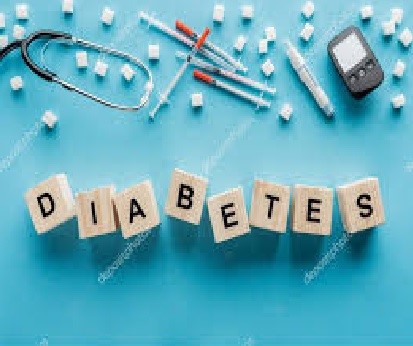Diabetes mellitus (DM), commonly known as diabetes, is a group of metabolic disorders characterized by a high blood sugar level over a prolonged period of time. Symptoms often include frequent urination, increased thirst, and increased appetite. If left untreated, diabetes can cause many complications. Acute complications can include diabetic ketoacidosis, hyperosmolar hyperglycemic state, or death. Serious long-term complications include cardiovascular disease, stroke, chronic kidney disease, foot ulcers, damage to the nerves, damage to the eyes and cognitive impairment.
Diabetes is due to either the pancreas not producing enough insulin, or the cells of the body not responding properly to the insulin produced. There are three main types of diabetes mellitus:
Type 1 diabetes results from the pancreas’s failure to produce enough insulin due to loss of beta cells. This form was previously referred to as “insulin-dependent diabetes mellitus” (IDDM) or “juvenile diabetes”. The loss of beta cells is caused by an autoimmune response. The cause of this autoimmune response is unknown.
Type 2 diabetes begins with insulin resistance, a condition in which cells fail to respond to insulin properly. As the disease progresses, a lack of insulin may also develop. This form was previously referred to as “non insulin-dependent diabetes mellitus” (NIDDM) or “adult-onset diabetes. The most common cause is a combination of excessive body weight and insufficient exercise.
Gestational diabetes is the third main form, and occurs when pregnant women without a previous history of diabetes develop high blood sugar levels.
Type 1 diabetes must be managed with insulin injections. Prevention and treatment of type 2 diabetes involves maintaining a healthy diet, regular physical exercise, a normal body weight, and avoiding use of tobacco. Type 2 diabetes may be treated with medications such as insulin sensitizers with or without insulin. Control of blood pressure and maintaining proper foot and eye care are important for people with the disease. Insulin and some oral medications can cause low blood sugar. Weight loss surgery in those with obesity is sometimes an effective measure in those with type 2 diabetes. Gestational diabetes usually resolves after the birth of the baby.
As of 2019, an estimated 463 million people had diabetes worldwide (8.8% of the adult population), with type 2 diabetes making up about 90% of the cases. Rates are similar in women and men. Trends suggest that rates will continue to rise. Diabetes at least doubles a person’s risk of early death. In 2019, diabetes resulted in approximately 4.2 million deaths. It is the 7th leading cause of death globally. The global economic cost of diabetes related health expenditure in 2017 was estimated at US$727 billion. In the United States, diabetes cost nearly US$327 billion in 2017. Average medical expenditures among people with diabetes are about 2.3 times higher.

